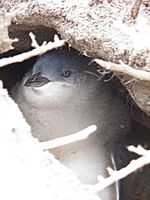Lipson Cove facts for kids
Quick facts for kids Lipson Cove |
|
|---|---|
| Location | South Australia |
| Coordinates | 34°15′36″S 136°15′47″E / 34.26000°S 136.26306°E |
| Type | Bay |
| Etymology | Thomas Lipson |
| Part of | Spencer Gulf |
| Basin countries | Australia |
| Max. length | about1.1 km (0.68 mi) |
| Average depth | 5.5 m (18 ft) |
| Islands | Lipson Island |
| Settlements | Lipson |
Lipson Cove is a peaceful sandy bay in South Australia. It's on the east coast of the Eyre Peninsula, looking out over Spencer Gulf. This beautiful spot was even featured in a book called 101 Best Australian Beaches! It's a great place for swimming, camping, and fishing.
Contents
Where is Lipson Cove?
Lipson Cove is about 215 kilometers west-northwest of Adelaide. It's also 63 kilometers northeast of Port Lincoln. The closest towns are Lipson (inland) and Port Neill (to the northeast). You can get there from the Lincoln Highway. Just follow the Lipson Cove Road. The road is unsealed, but it's usually in good condition. You can even camp right behind the sand dunes near the beach.
A Look Back at Lipson Cove's History
Lipson Cove got its name in 1840 from Governor George Gawler. He named it after Thomas Lipson, who was South Australia's very first harbor master.
The Old Jetty
In 1882, a long wooden jetty was built at the cove. It was about 100 meters long! This jetty was used to ship wool from nearby farms. Later, it helped trade wheat and other goods. Imagine all the ships coming and going!
By 1931, the jetty was getting old and needed many repairs. It was finally taken down in 1949. You can still see some parts of the old jetty piles in the water today.
Shipwrecks and Discoveries
Lipson Cove is also where the ketch (a type of sailing boat) Three Sisters sank. This happened on March 17, 1899. Sometimes, if the sand shifts, you can still see parts of the old wooden boat sticking out of the beach.
Fun Activities at the Cove
People love Lipson Cove for its great fishing from the shore. There's also an old talc mine nearby. The area has cool granite hills and cliffs that stretch north. It's known for its camping, beautiful coast, and safe swimming. Visitors have enjoyed this spot for a long time!
Lipson Island Conservation Park
Lipson Island is a small island about 150 meters from Lipson Cove beach. You can walk to it when the tide is low. But be careful! Make sure you don't get stuck when the tide comes back in.
Protecting Nature
The island and the area around it are part of the Lipson Island Conservation Park. This park was created in 1967 to protect the natural environment. It's a special place for many sea birds.
Island Wildlife
Many birds use Lipson Island as a safe place to rest and raise their young. You can find colonies of black-faced cormorants, crested terns, and little penguins here. The little penguin colony on Lipson Island is very important. It's one of the few that is still growing, while others in the area are shrinking.
Sooty oystercatchers have also been seen on the island. Sometimes, New Zealand fur seals visit the island too. Little penguins have been known to live in this area since at least 1954.
The island also has a French name, Ile d'Alembert. This name was given by the French explorer Nicolas Baudin.
Wildlife at Lipson Cove
Lipson Cove and the surrounding areas are home to many amazing animals. Some of these are very special and need protection.
Birds of the Bay
You might spot hooded plovers and fairy terns on the beaches. Look up, and you might see a majestic White-bellied sea eagle flying overhead. Migratory shorebirds like the Sanderling and Sharp-tailed sandpiper also visit the area.
Marine Life
The waters around Lipson Cove are busy with marine life. Bottlenose dolphins often swim and play here. If you're lucky, you might even see a huge Southern right whale passing by! And yes, Great white sharks are known to visit these waters too.
Other Animals
Unfortunately, some animals that are not native to Australia have also been seen here. These include the red fox, rock pigeon, and European starling. Scientists and nature lovers have identified many different plants and animals in and around Lipson Cove.
Future Plans for the Area
There have been ideas to build a large port near Lipson Cove. This port would be used to export goods like grain. The proposed site is just north of the cove.
Community Concerns
These plans have caused some worries for local people and environmental groups. They are concerned about how a big port might affect the beautiful Lipson Cove and Lipson Island. They want to make sure the area stays a great place for recreation and for its important wildlife.
Gallery






